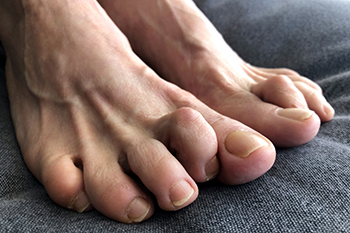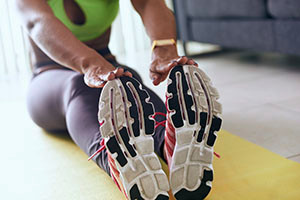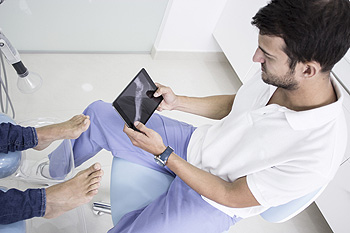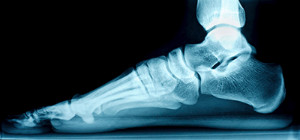Items filtered by date: January 2024
Definition and Causes of Hammertoe

Hammertoe, a common foot ailment, unfolds as a deformity characterized by an abnormal bending of the toe joints. The condition primarily affects the second, third, or fourth toe, causing it to resemble a hammer's curved shape. One of the key causes of hammertoe is an imbalance in the muscles and tendons that control toe movement, leading to joint misalignment. Wearing ill-fitting shoes with narrow or high toe boxes can exacerbate the problem, cramping the toes and impeding their natural movement. Additionally, genetic predisposition and certain medical conditions, such as arthritis or diabetes, may increase susceptibility to developing hammertoe. Understanding the definition and underlying causes of hammer toe is essential for early intervention. If you have developed hammertoe, it is suggested that you visit a podiatrist who can guide you toward successful treatment and prevention methods.
Hammertoe
Hammertoes can be a painful condition to live with. For more information, contact Leonora Fihman, DPM from California. Our doctor will answer any of your foot- and ankle-related questions.
Hammertoe is a foot deformity that affects the joints of the second, third, fourth, or fifth toes of your feet. It is a painful foot condition in which these toes curl and arch up, which can often lead to pain when wearing footwear.
Symptoms
- Pain in the affected toes
- Development of corns or calluses due to friction
- Inflammation
- Redness
- Contracture of the toes
Causes
Genetics – People who are genetically predisposed to hammertoe are often more susceptible
Arthritis – Because arthritis affects the joints in your toes, further deformities stemming from arthritis can occur
Trauma – Direct trauma to the toes could potentially lead to hammertoe
Ill-fitting shoes – Undue pressure on the front of the toes from ill-fitting shoes can potentially lead to the development of hammertoe
Treatment
Orthotics – Custom made inserts can be used to help relieve pressure placed on the toes and therefore relieve some of the pain associated with it
Medications – Oral medications such as anti-inflammatories or NSAIDs could be used to treat the pain and inflammation hammertoes causes. Injections of corticosteroids are also sometimes used
Surgery – In more severe cases where the hammertoes have become more rigid, foot surgery is a potential option
If you have any questions please contact our offices located in Encino and Brentwood, Los Angeles, CA . We offer the newest diagnostic and treatment technologies for all your foot and ankle needs.
Definition and Causes of Hammertoe

Hammertoe, a common foot ailment, unfolds as a deformity characterized by an abnormal bending of the toe joints. The condition primarily affects the second, third, or fourth toe, causing it to resemble a hammer's curved shape. One of the key causes of hammertoe is an imbalance in the muscles and tendons that control toe movement, leading to joint misalignment. Wearing ill-fitting shoes with narrow or high toe boxes can exacerbate the problem, cramping the toes and impeding their natural movement. Additionally, genetic predisposition and certain medical conditions, such as arthritis or diabetes, may increase susceptibility to developing hammertoe. Understanding the definition and underlying causes of hammer toe is essential for early intervention. If you have developed hammertoe, it is suggested that you visit a podiatrist who can guide you toward successful treatment and prevention methods.
Hammertoe
Hammertoes can be a painful condition to live with. For more information, contact Leonora Fihman, DPM from California. Our doctor will answer any of your foot- and ankle-related questions.
Hammertoe is a foot deformity that affects the joints of the second, third, fourth, or fifth toes of your feet. It is a painful foot condition in which these toes curl and arch up, which can often lead to pain when wearing footwear.
Symptoms
- Pain in the affected toes
- Development of corns or calluses due to friction
- Inflammation
- Redness
- Contracture of the toes
Causes
Genetics – People who are genetically predisposed to hammertoe are often more susceptible
Arthritis – Because arthritis affects the joints in your toes, further deformities stemming from arthritis can occur
Trauma – Direct trauma to the toes could potentially lead to hammertoe
Ill-fitting shoes – Undue pressure on the front of the toes from ill-fitting shoes can potentially lead to the development of hammertoe
Treatment
Orthotics – Custom made inserts can be used to help relieve pressure placed on the toes and therefore relieve some of the pain associated with it
Medications – Oral medications such as anti-inflammatories or NSAIDs could be used to treat the pain and inflammation hammertoes causes. Injections of corticosteroids are also sometimes used
Surgery – In more severe cases where the hammertoes have become more rigid, foot surgery is a potential option
If you have any questions please contact our offices located in Encino and Brentwood, Los Angeles, CA . We offer the newest diagnostic and treatment technologies for all your foot and ankle needs.
Common Running Injuries and Prevention Strategies

Engaging in running offers numerous health benefits, but it also comes with the risk of encountering common injuries that can sideline even the most dedicated runners. One common issue is plantar fasciitis, causing heel pain. This condition is often a result of overuse or improper footwear. Regular stretching and wearing supportive shoes can be preventive measures. Achilles tendinitis, involving inflammation of the Achilles tendon, emphasizes the importance of gradual training increments and proper footwear. Prioritizing rest, cross-training, and incorporating strength exercises into one's routine can significantly reduce the risk of these common running injuries, ensuring a more enjoyable and injury-free running experience. If you are experiencing foot, toe, or ankle injuries related to running, it is suggested that you consult a podiatrist who can recommend effective treatment options.
All runners should take extra precaution when trying to avoid injury. If you have any concerns about your feet, contact Leonora Fihman, DPM of California. Our doctor will treat your foot and ankle needs.
How to Prevent Running Injuries
There are a lot of mistakes a runner can make prior to a workout that can induce injury. A lot of athletes tend to overstretch before running, instead of saving those workouts for a post-run routine. Deep lunges and hand-to-toe hamstring pulls should be performed after a workout instead of during a warmup. Another common mistake is jumping into an intense routine before your body is physically prepared for it. You should try to ease your way into long-distance running instead of forcing yourself to rush into it.
More Tips for Preventing Injury
- Incorporate Strength Training into Workouts - This will help improve the body’s overall athleticism
- Improve and Maintain Your Flexibility – Stretching everyday will help improve overall performance
- “Warm Up” Before Running and “Cool Down” Afterward – A warm up of 5-10 minutes helps get rid of lactic acid in the muscles and prevents delayed muscle soreness
- Cross-Training is Crucial
- Wear Proper Running Shoes
- Have a Formal Gait Analysis – Poor biomechanics can easily cause injury
If you have any questions, please feel free to contact our offices located in Encino and Brentwood, Los Angeles, CA . We offer the newest diagnostic and treatment technologies for all your foot care needs.
Common Running Injuries and Prevention Strategies

Engaging in running offers numerous health benefits, but it also comes with the risk of encountering common injuries that can sideline even the most dedicated runners. One common issue is plantar fasciitis, causing heel pain. This condition is often a result of overuse or improper footwear. Regular stretching and wearing supportive shoes can be preventive measures. Achilles tendinitis, involving inflammation of the Achilles tendon, emphasizes the importance of gradual training increments and proper footwear. Prioritizing rest, cross-training, and incorporating strength exercises into one's routine can significantly reduce the risk of these common running injuries, ensuring a more enjoyable and injury-free running experience. If you are experiencing foot, toe, or ankle injuries related to running, it is suggested that you consult a podiatrist who can recommend effective treatment options.
All runners should take extra precaution when trying to avoid injury. If you have any concerns about your feet, contact Leonora Fihman, DPM of California. Our doctor will treat your foot and ankle needs.
How to Prevent Running Injuries
There are a lot of mistakes a runner can make prior to a workout that can induce injury. A lot of athletes tend to overstretch before running, instead of saving those workouts for a post-run routine. Deep lunges and hand-to-toe hamstring pulls should be performed after a workout instead of during a warmup. Another common mistake is jumping into an intense routine before your body is physically prepared for it. You should try to ease your way into long-distance running instead of forcing yourself to rush into it.
More Tips for Preventing Injury
- Incorporate Strength Training into Workouts - This will help improve the body’s overall athleticism
- Improve and Maintain Your Flexibility – Stretching everyday will help improve overall performance
- “Warm Up” Before Running and “Cool Down” Afterward – A warm up of 5-10 minutes helps get rid of lactic acid in the muscles and prevents delayed muscle soreness
- Cross-Training is Crucial
- Wear Proper Running Shoes
- Have a Formal Gait Analysis – Poor biomechanics can easily cause injury
If you have any questions, please feel free to contact our offices located in Encino and Brentwood, Los Angeles, CA . We offer the newest diagnostic and treatment technologies for all your foot care needs.
Podiatrists Are Foot Care Experts

Podiatrists are specialized healthcare professionals who focus on the diagnosis, treatment, and prevention of disorders related to the feet and lower extremities. Podiatrists undergo extensive education and training, equipping them with the knowledge to address a spectrum of foot conditions, from common ailments to complex issues. Their responsibilities encompass conducting thorough examinations, utilizing diagnostic tools, and devising personalized treatment plans. Podiatrists commonly treat conditions such as bunions, heel pain, and toenail disorders. They may also provide guidance on proper foot care, footwear selection, and preventive measures. These professionals operate in diverse settings, including private practices, hospitals, and outpatient clinics. Some podiatrists specialize further in areas, such as sports medicine or surgery, offering comprehensive care for individuals of all ages. If you have foot or ankle problems, it is suggested that you make an appointment with a podiatrist.
If you are dealing with pain in your feet and ankles, you may want to seek help from a podiatrist. Feel free to contact Leonora Fihman, DPM from California. Our doctor can provide the care you need to keep you pain-free and on your feet.
What Is a Podiatrist?
A podiatrist is a doctor of podiatric medicine who diagnoses and treats conditions of the foot, ankle, and related structures of the leg. Your podiatrist may specialize in a certain field such as sports medicine, wound care, pediatrics, and diabetic care. Podiatrists have the ability to become board certified through training, clinical experience, and then taking an exam.
What Do Podiatrists Do?
On a daily basis, a podiatrist may perform the following activities:
- Diagnose foot ailments such as ulcers, tumors, fractures, etc.
- Use innovative methods to treat conditions
- Use corrective orthotics, casts, and strappings to correct deformities
- Correct walking patterns and balance
- Provide individual consultations to patients
It is very important that you take care of your feet. It’s easy to take having healthy feet for granted, however foot problems tend to be among the most common health conditions. Podiatrists can help diagnose and treat a variety of feet related conditions, so it is crucial that you visit one if you need assistance.
If you have any questions please feel free to contact our offices located in Encino and Brentwood, Los Angeles, CA . We offer the newest diagnostic and treatment technologies for all your foot and ankle needs.
Podiatrists Are Foot Care Experts

Podiatrists are specialized healthcare professionals who focus on the diagnosis, treatment, and prevention of disorders related to the feet and lower extremities. Podiatrists undergo extensive education and training, equipping them with the knowledge to address a spectrum of foot conditions, from common ailments to complex issues. Their responsibilities encompass conducting thorough examinations, utilizing diagnostic tools, and devising personalized treatment plans. Podiatrists commonly treat conditions such as bunions, heel pain, and toenail disorders. They may also provide guidance on proper foot care, footwear selection, and preventive measures. These professionals operate in diverse settings, including private practices, hospitals, and outpatient clinics. Some podiatrists specialize further in areas, such as sports medicine or surgery, offering comprehensive care for individuals of all ages. If you have foot or ankle problems, it is suggested that you make an appointment with a podiatrist.
If you are dealing with pain in your feet and ankles, you may want to seek help from a podiatrist. Feel free to contact Leonora Fihman, DPM from California. Our doctor can provide the care you need to keep you pain-free and on your feet.
What Is a Podiatrist?
A podiatrist is a doctor of podiatric medicine who diagnoses and treats conditions of the foot, ankle, and related structures of the leg. Your podiatrist may specialize in a certain field such as sports medicine, wound care, pediatrics, and diabetic care. Podiatrists have the ability to become board certified through training, clinical experience, and then taking an exam.
What Do Podiatrists Do?
On a daily basis, a podiatrist may perform the following activities:
- Diagnose foot ailments such as ulcers, tumors, fractures, etc.
- Use innovative methods to treat conditions
- Use corrective orthotics, casts, and strappings to correct deformities
- Correct walking patterns and balance
- Provide individual consultations to patients
It is very important that you take care of your feet. It’s easy to take having healthy feet for granted, however foot problems tend to be among the most common health conditions. Podiatrists can help diagnose and treat a variety of feet related conditions, so it is crucial that you visit one if you need assistance.
If you have any questions please feel free to contact our offices located in Encino and Brentwood, Los Angeles, CA . We offer the newest diagnostic and treatment technologies for all your foot and ankle needs.
The Dynamics of Adult Acquired Flat Feet

Adult-acquired flat feet, a condition marked by the gradual collapse of the arches, pose unique challenges for those affected. Unlike the common perception that flat feet only afflict children, this ailment can emerge in adulthood due to various factors. Weakening tendons, wear and tear over time, and injuries contribute to the loss of arch height, altering the foot's biomechanics. This can lead to pain, swelling, and difficulty with mobility. In some cases, underlying conditions such as arthritis exacerbate the problem. Individuals with adult-acquired flat feet may notice a progressive change in the shape of their feet and experience discomfort during prolonged standing or walking. While wearing supportive footwear and orthotics can alleviate symptoms, seeking professional guidance from a podiatrist is paramount. If you have flat feet, it is suggested that you are under the care of this type of doctor who can offer you relief techniques.
Flatfoot is a condition many people suffer from. If you have flat feet, contact Leonora Fihman, DPM from California. Our doctor will treat your foot and ankle needs.
What Are Flat Feet?
Flatfoot is a condition in which the arch of the foot is depressed and the sole of the foot is almost completely in contact with the ground. About 20-30% of the population generally has flat feet because their arches never formed during growth.
Conditions & Problems:
Having flat feet makes it difficult to run or walk because of the stress placed on the ankles.
Alignment – The general alignment of your legs can be disrupted, because the ankles move inward which can cause major discomfort.
Knees – If you have complications with your knees, flat feet can be a contributor to arthritis in that area.
Symptoms
- Pain around the heel or arch area
- Trouble standing on the tip toe
- Swelling around the inside of the ankle
- Flat look to one or both feet
- Having your shoes feel uneven when worn
Treatment
If you are experiencing pain and stress on the foot you may weaken the posterior tibial tendon, which runs around the inside of the ankle.
If you have any questions please feel free to contact our offices located in Encino and Brentwood, Los Angeles, CA . We offer the newest diagnostic and treatment technologies for all your foot and ankle needs.
The Dynamics of Adult Acquired Flat Feet

Adult-acquired flat feet, a condition marked by the gradual collapse of the arches, pose unique challenges for those affected. Unlike the common perception that flat feet only afflict children, this ailment can emerge in adulthood due to various factors. Weakening tendons, wear and tear over time, and injuries contribute to the loss of arch height, altering the foot's biomechanics. This can lead to pain, swelling, and difficulty with mobility. In some cases, underlying conditions such as arthritis exacerbate the problem. Individuals with adult-acquired flat feet may notice a progressive change in the shape of their feet and experience discomfort during prolonged standing or walking. While wearing supportive footwear and orthotics can alleviate symptoms, seeking professional guidance from a podiatrist is paramount. If you have flat feet, it is suggested that you are under the care of this type of doctor who can offer you relief techniques.
Flatfoot is a condition many people suffer from. If you have flat feet, contact Leonora Fihman, DPM from California. Our doctor will treat your foot and ankle needs.
What Are Flat Feet?
Flatfoot is a condition in which the arch of the foot is depressed and the sole of the foot is almost completely in contact with the ground. About 20-30% of the population generally has flat feet because their arches never formed during growth.
Conditions & Problems:
Having flat feet makes it difficult to run or walk because of the stress placed on the ankles.
Alignment – The general alignment of your legs can be disrupted, because the ankles move inward which can cause major discomfort.
Knees – If you have complications with your knees, flat feet can be a contributor to arthritis in that area.
Symptoms
- Pain around the heel or arch area
- Trouble standing on the tip toe
- Swelling around the inside of the ankle
- Flat look to one or both feet
- Having your shoes feel uneven when worn
Treatment
If you are experiencing pain and stress on the foot you may weaken the posterior tibial tendon, which runs around the inside of the ankle.
If you have any questions please feel free to contact our offices located in Encino and Brentwood, Los Angeles, CA . We offer the newest diagnostic and treatment technologies for all your foot and ankle needs.

